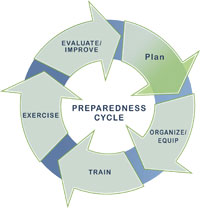 Planning makes it possible to manage the entire life cycle of a potential crisis. Strategic and operational planning establishes priorities, identifies expected levels of performance and capability requirements, provides the standard for assessing capabilities and helps stakeholders learn their roles. The planning elements identify what an organization’s Standard Operating Procedures (SOPs) or Emergency Operations Plans (EOPs) should include for ensuring that contingencies are in place for delivering the capability during a large-scale disaster.
Planning makes it possible to manage the entire life cycle of a potential crisis. Strategic and operational planning establishes priorities, identifies expected levels of performance and capability requirements, provides the standard for assessing capabilities and helps stakeholders learn their roles. The planning elements identify what an organization’s Standard Operating Procedures (SOPs) or Emergency Operations Plans (EOPs) should include for ensuring that contingencies are in place for delivering the capability during a large-scale disaster.
The National Response Framework presents the guiding principles that enable all response partners to prepare for and provide a unified national response to disasters and emergencies - from the smallest incident to the largest catastrophe. The Framework establishes a comprehensive, national, all-hazards approach to domestic incident response.
Preparedness Technical Assistance
Preparedness Technical Assistance (TA) services seek to build and sustain capabilities in support of the preparedness mission area. These services address the suite of priorities and capabilities outlined in the National Preparedness Guidelines. As capability gaps are identified within state, local, tribal and territorial jurisdictions, Preparedness TA services are designed, developed and delivered to address those needs and build capabilities in the most critical areas. For more information on available services and to request support, go to the Homeland Security Virtual Assistance Center: hsvac.dhs.gov.
Comprehensive Preparedness Guide 101 Version 2.0 (PDF 1.9MB, TXT 640KB)
FEMA’s Comprehensive Preparedness Guide (CPG) 101 Version 2.0 provides guidance on the fundamentals of planning and development of Emergency Operations Plans (EOP). Following the initial release of CPG 101 in March 2009, FEMA solicited additional input from federal, state, territorial, tribal, local and private sector stakeholders, which led to the development of a more user-friendly document that reflects recent initiatives and the current planning environment. CPG 101 Version 2.0 encourages emergency and homeland security managers to engage the whole community in addressing all of the risks that might impact their jurisdictions. This version of CPG 101 replaces all previous versions of CPG 101 and is the cornerstone for a series of CPGs that provide planning considerations for a variety of hazards, security issues and emergency functions. Supplements to 101 will be issued as needed to expand on aspects of the guidance.
- Plan Analysis Tool (XLS 36KB, PDF 63KB, TXT 10KB): The Plan Analysis Tool supplements CPG 101 by providing a one-page matrix to track the development timeline for a new plan or the revision of an existing plan. The tool also captures the planning elements contained in CPG 101 to support the analysis by a jurisdiction of its existing plans.
Comprehensive Preparedness Guide 201
- Threat and Hazard Identification and Risk Assessment Guide Backgrounder
- Threat and Hazard Identification and Risk Assessment Guide (CPG) 201
- Threat and Hazard Identification and Risk Assessment Guide: Toolkit
FEMA’s Comprehensive Preparedness Guide (CPG) 201 focuses on the conduct of risk assessments. This Threat and Hazard Identification and Risk Assessment (THIRA) Guide provides a comprehensive approach for identifying and assessing risks and associated impacts. Understanding the risks faced by communities and the nation as a whole and how this information can be used to build and sustain preparedness is an essential component of the National Preparedness System. It expands on existing local, tribal, territorial and state Hazard Identification and Risk Assessments (HIRAs) and other risk methodologies by broadening the factors considered in the process, incorporating the whole community throughout the entire process and by accounting for important community-specific factors. This THIRA guide provides a common and consistent approach for identifying and assessing risks and their associated impacts. The THIRA is complemented by a Strategic National Risk Assessment (SNRA) that analyzes the greatest risks to the nation and contributes to a shared understanding of the full range of risks, including long-term trends that face our nation. THIRAs and the SNRA, along with specialized risk assessments, provide an integrated national risk picture. Producing that integrated risk picture and achieving the National Preparedness Goal requires participation by the whole community. Consistent conduct and application of THIRAs provides an important tool for integrating whole community contributions toward achieving the Goal and to educate individuals, families, businesses, organizations, community leaders and senior officials on the risks they face and on their roles in and contributions to prevention, protection, mitigation, response and recovery.
Comprehensive Preparedness Guide 502 (PDF 4.6MB, TXT 181KB)
FEMA’s Comprehensive Preparedness Guide (CPG) 502 focuses on the critical partnership and the exchange of information between fusion centers and Emergency Operations Centers (EOC). The guide does not provide a “one-size fits all” approach to fusion center and EOC coordination. Rather, it outlines the information sharing roles of fusion centers and EOCs while identifying the planning and coordination considerations each entity must take into account. This guide outlines considerations for the following as they pertain to fusion centers and EOCs: Familiarization with Capabilities, Needs and Requirements; Establishing Partnerships; Determining Processes and Training, Workshops and Exercises.
Regional Catastrophic Preparedness Grants
The Regional Catastrophic Preparedness Grant Program (RCPGP) is intended to support coordination of regional all-hazard planning for catastrophic events, including the development of integrated planning communities, plans, protocols, and procedures to manage a catastrophic event.

